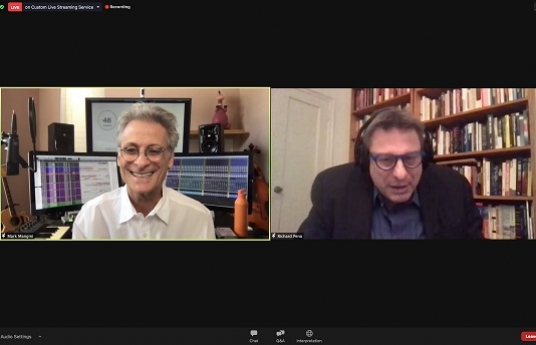Innovate to break sound tropes and make it real, advises Qumra Master Mark Mangini
Mar 15, 2021

- Academy Award-winning, and five-time nominated sound designer, Mark Mangini shared vital importance of sound in realising the full creative expression of films in Qumra Masterclass
Doha, Qatar; March 15, 2021: Sound could not have become more evocative a topic of discussion than in the Qumra Masterclass by Mark Mangini, Academy-award winner and five-time nominated sound designer.
In conversation with Richard Peña, the Programme Director of the Film Society of Lincoln Center and the Director of the New York Film Festival from 1988 until 2012, at Qumra, the Doha Film Institute’s annual talent incubator for Arab cinema, Mangini was his candid self, taking listeners through the process of designing sound for his films, including Blade Runner 2049 (2017), Star Trek IV: The Voyage Home (1986), Gremlins (1984) and more.
Befitting the concept of a master-class, Mangini shared insights on how he created sounds, collecting them and drawing inspiration from anything around him – including several fascinating food analogies. Endorsing new technology, he said the “advent of digital recording and editing revolutionised the industry.” Calling himself an “old-timer”, he quickly adapted and rehauled his skills. “I love hard drives and repeatability: The single biggest change that occurred in my arena – sound design – [influenced] not just how we produce sound but also how we exhibit sound for films.”
Mangini said sound has a great role to play in delivering the essence of the story in filmmaking – the suspension of disbelief. “You know what you are doing is not real and your role is to support the filmmaker’s conviction to create something closer to reality. The advances in technology gives us to tools to create new versions of reality, whether it is fabricated or not.”
Mangini said he creates an alternate sound reality, and this meant he had to push the boundaries of his approach to sound design. He broke conventions of approaching sound design in the silo of post-production and stressed the importance of working closely right from the pre-production stage. “Every phase of producing a motion picture must have sound design engaged,” he said. “Sound can be used as a very efficient story-telling tool that can quickly speak to audience in addition to dialogue or conversation. You must hear what somebody is trying to tell you – that is elegant filmmaking.”
Writers contact him when they have a narrative roadblock, said Mangini. “They ask if I can use sound to get past the block in a more elegant way than we can say it in words.” His involvement as a sound designer has even extended to the editing table, where his and the editor’s work can be complementing and uplifting for the movie.
He delved deep into creating sounds for movies such as Blade Runner 2049, creating what he said was ‘the Blade Runner’ sound – which combined music and sound in a way where “they never competed with each other.” He recalled the film’s director Denis Villeneuve asking him “erase the boundary between sound and music. He wanted audience to switch off the critique within.” They studied the 1982 Blade Runner in detail and what they took from the film – and is their tribute to it – “is the mood, the unusual tonalities.”
Mangini said he has an extensive sound library of over 60,000, and he is constantly finding new ways to create sounds that befit the mood of the film, going to lengths such as hiring a metal scrapyard to capture the sound of metal clashing on metal and placing sound recorders across a bee farm to capture the buzz of honeybees. He explained how to bring out the magic of silence through the use of sound and detailed the ‘Top of the Pyramid’ approach of director George Miller (Mad Max 2).
“George Miller was a very visionary filmmaker; we had a second unit sound crew that recorded sounds. In our first meeting, he drew out the ‘Top of the Pyramid’ for me – explaining that in any given shot, there is a lot to look at and listen.” Mangini’s task? To create “that one sound the audience hears to the exclusion of everything else.”
He advised young filmmakers to build a collection of real sounds, to avoid synthetic sounds, to revisit the sounds they have created, and to innovate and break the tropes of sounds.
Other Qumra Masters, who will share their insights this year are: BAFTA and Academy Award® nominated cinematographer Phedon Papamichael, internationally celebrated director and Cannes veteran James Gray, and Silver Lion winning film director and screenwriter Jessica Hausner.
Public can access Qumra online by purchasing a Qumra Pass that offers the full Qumra Screenings and Qumra Talks programmes. Qumra Pass is open to all citizens and residents of Qatar and the MENA region, and applications will be processed on a first-come first-serve basis. The Qumra Pass is priced at QAR 500; students and Culture Pass by Qatar Museums holders can purchase it for a discounted price of QAR 350.